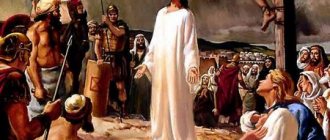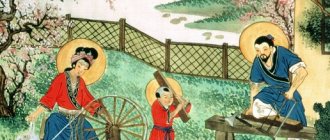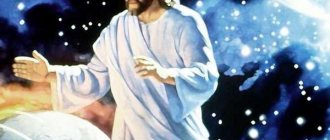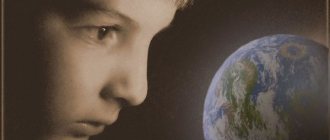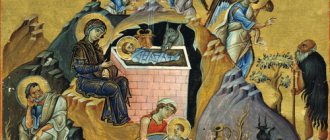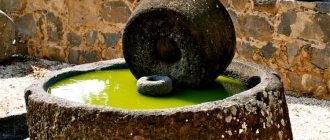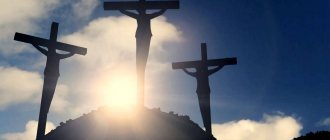Why was Jesus Christ crucified?
The meaning of death, burial and Resurrection Jesus Christ Himself told people. His words and actions remained in the Gospel, in the interpretations of the apostles - their Epistles from the New Testament, and in the interpretations of the holy fathers - teachers of the Church. Everyone can learn more about this from a conversation with a priest or at church courses. We will briefly talk about the last days of the Lord’s earthly life, His Crucifixion and Resurrection, as well as the significance of these events for the Orthodox Christian and the holidays of the Church.
The most important thing about His voluntary Sacrifice for people - and the Lord allowed Him to be crucified - Christ told the apostles at the Last Supper. The day before, He solemnly entered Jerusalem - this holiday is celebrated as Palm Sunday.
The Lord enters Jerusalem, where the inhabitants are waiting for Him to reign in the world, wanting to support Him as a military leader in the fight against Roman rule. But He enters the city meekly, on a donkey. People greet him with shouts of “Hosanna” and palm branches - but after five years the same people will shout “Crucify Him!” - because Jesus Christ did not live up to their hopes as a worldly power. That's why this holiday is sad. All believers in Slavic countries come to churches with palm branches - this is the first tree that begins to produce buds in early spring - and in southern countries people come to churches with flowers and the same palm branches. They mean that Orthodox people truly welcome Christ as the Heavenly King, but they also remind us to pray for our spiritual victories, not our worldly success. After Palm Sunday, the strict fasting of Holy Week and preparation for Easter begin.
At the Last Supper, the Lord gave the last instructions to the apostles, again reminding them that He must leave them, dying a terrible death. Christ calls the disciples children - as never before - and calls them to love one another as God Himself loves them. For the sake of strengthening their faith and the birth of the Church, sealed by the Body of Christ Himself, the Lord performs and establishes forever the greatest Sacrament that sealed the New Testament between God and man - the Sacrament of the Eucharist (in Greek thanksgiving), in Russian usually called the Sacrament of Communion.
Vecherya in Russian means dinner. It was secret because at that moment the Pharisees were already looking for Christ, expecting the betrayal of Judas, for the sake of putting the Lord to death. Christ, as the Omniscient God, knew that this dinner was the last, and he made it in secret so that the important meal would not be interrupted. He chose the place in Jerusalem, now called the Zion Upper Room.
This evening became a turning point in the history of the Church and all mankind. All the days of the end of the earthly life of the Lord Jesus Christ - the Last Supper, the Crucifixion, the Resurrection - were filled with mysterious theological meaning and events that created further history.
Christ took the bread into His hands and, blessing it with a sign, broke it, then poured wine and distributed everything to the disciples, saying: “Take and eat: this is My Body and My Blood.” With these words, priests to this day bless wine and bread during the Liturgy, when they are transformed into the Body and Blood of Christ.
The meal was served in the evening, since Christ followed one of the Jewish traditions of the Old (Old) Testament, on the basis of which he established the New Testament traditions, without destroying the previous ones. So, on that day the holiday of Passover was celebrated, the memory of the exodus of the ancestors of the Jews from Egypt at night. On that ancient day, every Jewish family had to slaughter a lamb and mark its blood on the door so that God would not direct His wrath at them. This was a sign of the election of the Jews. On that day, God the Father punished the Egyptians for keeping the Jews in slavery by the death of their firstborn. Only after this terrible execution did Pharaoh release the tribe of the Jews, led by the prophet Moses, to the Land Promised by God.
At the Last Supper, Jesus Christ, remembering this holiday, establishes a new one: God no longer needs sacrificial killings of animals and sacrificial blood, because the only Sacrificial Lamb, the Lamb remains the Son of God Himself, who dies so that the wrath of God for every sin would pass over a person who believes in Christ , partaking of Him.
After the words of Christ: “Take and eat: this is My Body and My Blood,” - by the grace of the Savior, bread and wine, having their former appearance, then ceased and cease now at every Liturgy to be earthly things. They become, according to the Gospel word, bread, that is, the food of life - the Flesh of Christ, which He gives for the forgiveness of all human sins.
Then the Lord went to pray in the Garden of Gethsemane with the disciples. According to the evangelists, Christ prayed three times, until he sweated blood. In the first prayer, He asked God the Father not to drink the Cup of suffering, saying at the same time that it would happen as God wanted. Christ expressed his fear and anguish before suffering. Then He prayed with complete submission to the will of God and the understanding that He could not escape torment. Evangelist Luke writes that at this time God the Father sent Him an Angel who supported Christ. For the third time, the Lord repeated the words of His acceptance of the will of God and turned to the disciples, waking them up and saying that a traitor was approaching, who would deliver Him into the hands of sinners. He even called on the disciples to go with Him in order to surrender themselves to the guards Himself.
At that moment, Judas and the guards approached Him, pointing them to the Lord.
Story
Once upon a time there was a village in the vicinity of Paris, which in 1860 was annexed to the capital of France. At one time, artists and poets, composers and writers lived here, who later became celebrities, including Zola, Berlioz, Renoir, Van Gogh and Picasso.
The convenient strategic position attracted conquerors to Montmartre - in 1590 the troops of Henry of Navarre, in 1814 - the Cossacks and in 1870 - the Prussians.
Montmartre has still retained the spirit of the province, thanks to its inhabitants, preserved cozy houses, cafes and vineyards.
Famous restaurants
Many celebrities spent time in cafes and cabarets in Montmartre.
- On Rue Sol, at number 22, there is a restaurant called “The Artful Rabbit,” which Pablo Picasso loved to visit, who came here with his friends, the poets Max Jacob and Guillaume Apollinaire. The very young Ilya Ehrenburg often joined their company. For a long time, on the wall of the cabaret hung a painting donated by Picasso and currently in a private collection in the USA. The Artful Rabbit cabaret still maintains a tradition - visitors take part in the concerts, singing along with the singers and musicians. This place is quite expensive - the entrance to the restaurant alone costs 24 euros (closed in 2015).
- Not far from the cabaret is Place Emile Goudeau, where the “Floating Laundry” was located - Bateau Lavoir , which looked like a barge from which local washerwomen washed clothes. It was a hostel under the roof of which lived a large company of artists and writers, for example, Picasso and Modigliani. Nowadays there are artist workshops in Bateau Lavoir
- One of the attractions of Montmartre is the windmill located on the top of the hill, Moulin de la Galette , which can be seen in the paintings of Renoir and other artists. In 1814, its owners, unlike other civilians in Montmartre, resisted the Russian Cossacks and fought back to the last bullet. According to legend, their bodies were crucified on the wings of the mill. The descendants of the mill owners did not organize a memorial here, but organized a bistro with a dance hall. The establishment, which became popular, was often visited by many artists: Pierre Auguste Renoir, Henri Toulouse-Lautrec and Ramon Casas, Vincent Van Gogh and Pablo Picasso. Now it is an architectural monument protected by the state, and the restaurant where biscuits are baked from local grain is located a little lower on the hill and has its own prop mill, the Moulin Rade.
- At the foot of Montmartre on Boulevard Clichy is the famous cabaret Moulin Rouge . The area around the Moulin Rouge has a bad reputation. And although prostitution is not legalized in France, local brothels are thriving. Vulgar young ladies clearly hint at the type of their activity and invite passers-by inside their houses.
Montmartre Museum
On Rue Cortot, next to the vineyards, in an old house from the 17th century, the Montmartre Museum is located. This ancient building is famous for the fact that it housed the studio of Auguste Renoir and that the circus acrobat and artist Suzanne Valadon and her son, the artist Maurice Utrillo, lived in this house for several decades.
The museum's exhibits will tell you about the history of Montmartre, among its exhibitions are “Festive Montmartre” and “La Boheme of Montmartre”; there is a library, the collection of which includes recordings of French chanson.
How to get there
There are several ways to get to Montmartre.
- The first route, the front route, which most tourists choose, is the Anvers metro station. When exiting the metro, you will find yourself in front of a narrow street called Steinkerque with souvenir shops on both sides and crowds of tourists. At the end of it you will see the dome of the Sacre Coeur, and after passing the Steinkerque, you will find yourself in front of a large green slope filled with a variety of people - tourists, thieves and scammers, jugglers and ordinary Parisians. You can climb 237 steps to the top of the church, looking back from time to time and watching as a stunning view of Paris gradually opens up behind you. If you are completely weak or do not want to walk for some other reason, you can wait for the funicular, which is valid for a metro ticket
- Another route to Montmartre is the Abbesses metro station. The exit from the subway itself is an attraction. This is one of the surviving metro stations with decorations from the Art Nouveau era - a glass pavilion and lanterns created by the architect Guimard. The decoration of this station was moved here from the center, from the Hotel de Ville metro station. Guimard's openwork casting here goes well with the carousel installed nearby. For reference: The Art Nouveau style arose as a reaction to the cruelty of the industrial era; the Art Nouveau slogan was “beauty against machines.” To climb the hill, it is better to stock up on a paper map or a navigator, because the road up is winding and after the third turn you will no longer be able to tell which direction you are moving. There are much fewer tourists on this side of Montmartre and walking here is much more pleasant. On Place Abbes you will see the Church of Saint-Jean-l'Evangelist, built in 1897–1904. This is the first reinforced concrete church in Paris. From the outside it looks like an ordinary temple, but inside the domes with lanterns and Art Nouveau chandeliers look very attractive.
Wall of Love
On Abbes Square, in a cozy square, there is a house with a wall of love, on which a declaration of love is written in 311 languages, that is, in almost all languages of the world. The plaque was installed on October 15, 2000 in honor of the new millennium. On Valentine's Day, white doves are released here, but at any other time there is a corner of peace and tranquility here, a stone's throw from Montmartre.
Montmartre is an area of contrasts: streets with crowds of tourists from various countries give way to quiet green alleys, where it is difficult to meet a living person. This is an area where famous vineyards and cozy two- and three-story houses are preserved, located on winding and steep streets.
Monument to the writer Marcel Aime
On a small square in Marseille Aimé, there is a monument to the writer in the form of an unusual sculpture called “A Man Passing Through a Wall” in honor of the work of the same name. The hero of the novel had the ability to penetrate walls and thus visit his beloved, locked away by a jealous husband. The monument depicts the main character stuck in the wall, but the sculpture is given a portrait resemblance to the writer’s appearance. The author of the monument is Jean Marais, who is better known as an actor.
Shaking the hand of bronze Marcel Aimé is considered a good sign that will definitely bring good luck and fulfillment of desires.
Basilica of Sacre Coeur
The idea of building the Sacré Coeur Basilica, literally the Basilica of the Sacred Heart, was expressed in 1875 by Parisians Alexandre Legenti and Hubert de Fleury. In their opinion, all the hardships of the French - defeat in the Franco-Prussian War in 1871 and the defeat of the Paris Commune were sent for the worldly sins of the inhabitants of France, and the construction of the temple will help atone for their sins.
This proposal was approved by the Archbishop of Paris Guibert, who chose the site for the temple on the Montmartre hill, where Bishop Saint Dionysius died.
Construction of the basilica began in 1875 with funds from French citizens in memory of the French who died during the war in 1870-1871 with Prussia. The material used was limestone, which gives the church a white tint. The hill itself reaches a height of 130 meters, and the height of the basilica was 94 meters, so the built temple became visible from almost many places in Paris.
Construction was carried out under the direction of the architect Paul Abadie, whose plan was to build a basilica in a mixed Roman-Byzantine style, which was supposed to be a statement of mutual consent and tolerance.
Paul Abadie was unable to see the completed basilica; he died in 1884, and the construction of the temple under the direction of five other architects continued for another 30 years and was completed in 1914.
Near the entrance of the Sacre Coeur Basilica there are bronze statues of Saint Louis and Joan of Arc. The main facade is decorated with five bas-reliefs on gospel themes, and at the top, near the dome, there is a snow-white sculpture of Jesus Christ. Nearby there is a high bell tower, one of the bells of which, “Savoyard,” was cast at the expense of residents of the French province of Savoy.
The interior of the temple has stained glass windows and a mosaic on the ceiling, made in azure and gold tones and depicting a scene of worship of the Sacred Heart of Jesus Christ. The sculptures of saints and the rays of light penetrating through the dome give the basilica a solemn and joyful appearance.
From the observation deck at the foot of the temple there is a view of Paris and Montmartre with its cute squares and small streets. If you wish, you can go up to the observation deck, from which you can see not only the capital of France, but also the surrounding area.
